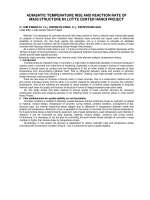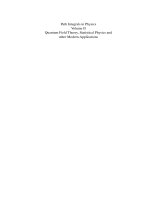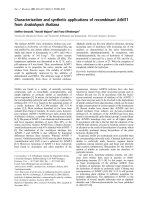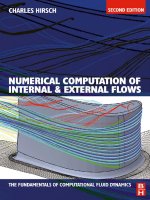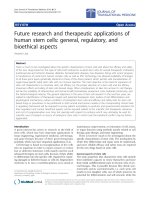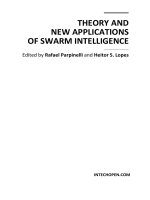principles and modern applications of mass transfer operations, second edition
Bạn đang xem bản rút gọn của tài liệu. Xem và tải ngay bản đầy đủ của tài liệu tại đây (21.71 MB, 650 trang )
PRINCIPLES AND MODERN
APPLICATIONS OF MASS
TRANSFER OPERATIONS
Second Edition
Jaime Benitez
@3
WILEY
A JOHN WILEY & SONS, INC., PUBLICATION
This page intentionally left blank
PRINCIPLES AND MODERN
APPLICATIONS OF MASS
TRANSFER OPERATIONS
This page intentionally left blank
PRINCIPLES AND MODERN
APPLICATIONS OF MASS
TRANSFER OPERATIONS
Second Edition
Jaime Benitez
@3
WILEY
A JOHN WILEY & SONS, INC., PUBLICATION
Copyright 02009 by John Wiley & Sons, Inc. All rights reserved.
Published by John Wiley & Sons, Inc., Hoboken, New Jersey.
Published simultaneously in Canada.
No part of this publication may be reproduced, stored in a retrieval system, or transmitted in any form or
by any means, electronic, mechanical, photocopying, recording, scanning, or otherwise, except as
permitted under Section 107 or 108 of the 1976 United States Copynght Act, without either the prior
written permission of the Publisher, or authorization through payment of the appropriate per-copy fee to
the Copyright Clearance Center, Inc., 222 Rosewood Drive, Danvers, MA 01923, (978) 750-8400, fax
(978) 750-4470, or on the web at www.copyright.com. Requests to the Publisher for permission should
be addressed to the Permissions Department, John Wiley & Sons, Inc., 11 1 River Street, Hoboken, NJ
07030, (201) 748-601 1, fax (201) 748-6008, or online at />Limit of LiabilityDisclaimer of Warranty: While the publisher and author have used their best efforts in
preparing this book, they make no representations or warranties with respect to the accuracy or
completeness of the contents of this book and specifically disclaim any implied warranties of
merchantability or fitness for a particular purpose. No warranty may be created or extended by sales
representatives or written sales materials. The advice and strategies contained herein may not be suitable
for your situation. You should consult with a professional where appropriate. Neither the publisher nor
author shall be liable for any loss of profit or any other commercial damages, including but not limited
to special, incidental, consequential, or other damages.
For general information on our other products and services or for technical support, please contact our
Customer Care Department within the United States at (800) 762-2974, outside the United States at
(317) 572-3993 or fax (317) 572-4002.
Wiley also publishes its books in a variety of electronic formats. Some content that appears in print may
not be available in electronic format. For information about Wiley products, visit our web site at
www.wiley.com.
Library o Congress Cataloging-in-Publication Data:
f
Benitez, Jaime, 1948Principles and modem applications of mass transfer operations / Jaime Benitez.-2nd ed.
p. cm.
Includes index.
ISBN 978-0-470-18178-2 (cloth)
1. Mass transfer. 2. Chemical engineering. I. Title.
TP156.M3B44 2009
66W.284234~22
2008033274
Printed in the United States of America
1 0 9 8 7 6 5 4 3 2 1
A Jaime por ser un hijo tan especial;
tu sonrisa angelical es todo lo que necesito para ser feliz.
This page intentionally left blank
Table of Contents
Preface to the Second Edition
xvii
Preface to the First Edition
xix
Nomenclature
xxi
1. Fundamentals of Mass Transfer
1
1.1 INTRODUCTION .........................................................................................
1
.............................................
3
1.2.1 Concentrations .................................................................................................
1.2.2 Velocities and Fluxes .....................................................................................
1.2.3 The Maxwell-Stefan Relations .......................................................................
1.2.4 Fick's First Law for Binary Mixtures ............................................................
4
10
13
16
1.3 THE DIFFUSION COEFFICIENT ..............................................
17
1.3.1 Diffusion Coefficients for Binary Ideal Gas Systems ...................................
1.3.2 Diffusion Coefficients for Dilute Liquids ......................................................
1.3.3 Diffusion Coefficients for Concentrated Liquids ...........................................
1.3.4 Effective Diffusivities in Multicomponent Mixtures .....................................
18
24
30
31
1.2 MOLECULAR MASS TRANSFER
1.4 STEADY-STATE MOLECULAR DIFFUSION IN FLUIDS
......... 37
1.4.1 Molar Flux and the Equation of Continuity ..................................................
1.4.2 Steady-State Molecular Diffusion in Gases ..................................................
1.4.3 Steady-State Molecular Diffusion in Liquids ...............................................
1.5 STEADY-STATE DIFFUSION IN SOLIDS
................................
1.5.1 Steady-State Binary Molecular Diffusion in
Porous Solids ...............................................................................................
1.5.2 Knudsen Diffusion in Porous Solids .............................................................
1.5.3 Hydrodynamic Flow of Gases in Porous Solids ...........................................
37
38
53
56
58
59
62
vii
viii
Contents
1.5.4 “Dusty Gas” Model for Multicomponent Diffusion ......................................
64
1.6 DIFFUSION WITH HOMOGENEOUS REACTION ................... 65
1.7 ANALOGIES AMONG MOLECULAR TRANSFER
PHENOMENA .......................................................................................
70
PROBLEMS .......................................................................................................
72
REFERENCES ..................................................................................................
89
2. Convective Mass Transfer
91
2.1 INTRODUCTION ........................................................................................
91
2.2 MASS-TRANSFER COEFFICIENTS .................................................
92
2.2.1 Diffusion of A Through Stagnant B ...............................................................
2.2.2 Equimolar Counterdiffusion ...........................................................................
93
95
2.3 DIMENSIONAL ANALYSIS ....................................................................
97
2.3.1 The Buckingham Method ...............................................................................
97
2.4 FLOW PAST A FLAT PLATE; BOUNDARY LAYER
THEORY ......................................................................................................
103
2.5 MASS- AND HEAT-TRANSFER ANALOGIES .......................
110
2.6 CONVECTIVE MASS-TRANSFER CORRELATIONS ............ 119
2.6.1 Mass-Transfer Coefficients for Flat Plates ..................................................
2.6.2 Mass-Transfer Coefficients for a Single Sphere ..........................................
120
121
Contents
2.6.3 Mass-Transfer Coefficients for Single Cylinders ........................................
2.6.4 Turbulent Flow in Circular Pipes .................................................................
2.6.5 Mass Transfer in Packed and Fluidized Beds ..............................................
2.6.6 Mass Transfer in Hollow-Fiber
Membrane Modules ................................................................................
ix
126
127
133
136
2.7 ESTIMATION OF MULTICOMPONENT MASS-TRANSFER
COEFFICIENTS ....................................................................................... 140
PROBLEMS .....................................................................................................
142
REFERENCES ................................................................................................
156
3. lnterphase Mass Transfer
158
3.1 INTRODUCTION.......................................................................................
158
3.2 EQUILIBRIUM ...........................................................................................
158
3.3 DIFFUSION BETWEEN PHASES .....................................................
163
3.3.1 Two-Resistance Theory ................................................................................
3.3.2 Overall Mass-Transfer Coefficients .............................................................
3.3.3 Local Mass-Transfer Coefficients:
General Case ...........................................................................................
164
166
3.4 MATERIAL BALANCES ........................................................................
179
3.4.1 Countercurrent Flow ......................................................................................
3.4.2 Cocurrent Flow ............................................................................................
3.4.3 Batch Processes ............................................................................................
79
192
195
3.5 EQUILIBRIUM-STAGE OPERATIONS ....................................
196
171
X
Contents
PROBLEMS .....................................................................................................
202
REFERENCES ................................................................................................
218
4 . Equipment for Gas-Liquid Mass-Transfer
Operations
4.1 INTRODUCTION ....................................................................................
219
219
4.2 GAS-LIQUID OPERATIONS: LIQUID DISPERSED .............. 219
4.2.1 Types of Packing ..........................................................................................
4.2.2 Liquid Distribution .......................................................................................
4.2.3 Liquid Holdup ..............................................................................................
4.2.4 Pressure Drop ...............................................................................................
4.2.5 Mass-Transfer Coefficients ..........................................................................
220
224
225
230
236
4.3 GAS-LIQUID OPERATIONS: GAS DISPERSED ....................
242
4.3.1 Sparged Vessels (Bubble Columns) ..............................................................
4.3.2 Tray Towers ..................................................................................................
4.3.3 Tray Diameter ...............................................................................................
4.3.4 Tray Gas-Pressure Drop ...............................................................................
4.3.5 Weeping and Entrainment ............................................................................
4.3.6 Tray Efficiency .............................................................................................
243
249
252
256
258
260
PROBLEMS ......................................................................................................
267
REFERENCES ................................................................................................
281
5.Absorption and Stripping
5.1 INTRODUCTION ......................................................................................
283
283
Contents
xi
5.2 COUNTERCURRENT MULTISTAGE EQUIPMENT ............... 284
5.2.1 Graphical Determination of the Number of
Ideal Trays ...............................................................................................
5.2.2 Tray Efficiencies and Real Trays by Graphical Methods .............................
5.2.3 Dilute Mixtures .............................................................................................
284
285
286
5.3 COUNTERCURRENT CONTINUOUS-CONTACT
EQUIPMENT ......................................................................................
292
5.3.1 Dilute Solutions; Henry's Law .....................................................................
298
5.4 THERMAL EFFECTS DURING ABSORPTION AND
STRIPPING ........................................................................................
301
5.4.1 Adiabatic Operation of a Tray Absorber ......................................................
5.4.2 Adiabatic Operation of a Packed-Bed Absorber ..........................................
301
304
PROBLEMS ......................................................................................................
308
REFERENCES .................................................................................................
320
6. Distillation
321
6.1 INTRODUCTION ...................................................................................... 321
6.2 SINGLE-STAGE OPERATION: FLASH
VAPORIZATION ................................................................................
322
6.3 DIFFERENTIAL DISTILLATION .........................................................
327
6.4 CONTINUOUS RECTIFICATION: BINARY SYSTEMS .......... 330
xii
Contents
6.5 McCABE-THIELE METHOD FOR TRAYED TOWERS .......... 330
6.5.1 Rectifying Section ........................................................................................
6.5.2 Stripping Section ..........................................................................................
6.5.3 Feed Stage ....................................................................................................
6.5.4 Number of Equilibrium Stages and Feed-Stage Location ...........................
6.5.5 Limiting Conditions .....................................................................................
6.5.6 Optimum Reflux Ratio .................................................................................
6.5.7 Large Number of Stages ...............................................................................
6.5.8 Use of Open Steam .......................................................................................
6.5.9 Tray Efficiencies ...........................................................................................
332
333
335
338
338
341
347
351
352
6.6 BINARY DISTILLATION IN PACKED TOWERS .....................
360
6.7 MULTICOMPONENT DISTILLATION ......................................
365
6.8 FENSKE-UNDERWOOD-GILLILAND METHOD .....................
368
6.8.1 Total Reflux: Fenske Equation .....................................................................
6.8.2 Minimum Reflux: Underwood Equations ....................................................
6.8.3 Gilliland Correlation for Number of Stages at Finite Reflux ......................
368
372
379
6.9 RIGOROUS CALCULATION PROCEDURES FOR
MULTICOMPONENT DISTILLATION ...................................................
381
6.9.1 Equilibrium Stage Model .............................................................................
6.9.2 Nonequilibrium, Rate-Based Model ............................................................
6.9.3 ChemSep Program .......................................................................................
6.9.4 RATEFRAC Program ..................................................................................
382
383
389
397
6.10 BATCH DISTILLATION ......................................................................
397
6.10.1 Binary Batch Distillation with Constant Reflux ........................................
6.10.2 Batch Distillation with Constant Distillate Composition ..........................
6.10.3 Multicomponent Batch Distillation ............................................................
398
402
405
PROBLEMS ....................................................................................................
406
REFERENCES ................................................................................................
422
Contents
7. Liquid-Liquid Extraction
xiii
424
7.1 INTRODUCTION ......................................................................................
424
7.2 LIQUID EQUILIBRIA ..............................................................................
425
7.3 STAGEWISE LIQUID-LIQUID EXTRACTION ........................
431
7.3.1 Single-Stage Extraction ................................................................................
7.3.2 Multistage Crosscurrent Extraction ..............................................................
7.3.3 Countercurrent Extraction Cascades ............................................................
7.3.4 Insoluble Liquids ..........................................................................................
7.3.5 Continuous Countercurrent Extraction with Reflux ...................................
431
435
436
443
445
7.4 EQUIPMENT FOR LIQUID-LIQUID EXTRACTION ............... 452
7.4.1 Mixer-Settler Cascades .................................................................................
7.4.2 Multicompartment Columns .........................................................................
453
463
PROBLEMS .....................................................................................................
467
REFERENCES ................................................................................................
476
8. Humidification Operations
477
8.1 INTRODUCTION .....................................................................................
477
8.2 EQUILIBRIUM CONSIDERATIONS ........................................
478
8.2.1 Saturated Gas-Vapor Mixtures ....................................................................
8.2.2 Unsaturated Gas-Vapor Mixtures ................................................................
8.2.3 Adiabatic-SaturationCurves ........................................................................
8.2.4 Wet-Bulb Temperature .................................................................................
479
481
482
484
xiv
Contents
8.3 ADIABATIC GAS-LIQUID CONTACT OPERATIONS ........... 488
8.3.1 Fundamental Relationships ..........................................................................
8.3.2 Water Cooling with Air ................................................................................
8.3.3 Dehumidification of Air-Water Vapor .........................................................
488
491
499
PROBLEMS .....................................................................................................
499
REFERENCES ................................................................................................
504
9. Membranes. Solid Sorption Agents
505
9.1 INTRODUCTION .....................................................................................
505
9.2 MASS TRANSFER IN MEMBRANES .............................................
506
9.2.1 Solution-Diffusionfor Liquid Mixtures .......................................................
9.2.2 Solution-Diffusion for Gas Mixtures ...........................................................
9.2.3 Module Flow Patterns ..................................................................................
508
509
512
9.3 EQUILIBRIUM IN POROUS SORBENTS ...............................
517
9.3.1 Adsorption and Chromatography Equilibria ...............................................
9.3.2 Ion-Exchange Equilibria ..............................................................................
518
523
9.4 MASS TRANSFER IN FIXED BEDS OF
POROUS SORBENTS ...........................................................................
527
9.4.1 Basic Equations for Adsorption ...................................................................
9.4.2 Linear Isotherm ............................................................................................
9.4.3 Langmuir Isotherm .......................................................................................
9.4.4 Length of Unused Bed .................................................................................
9.4.5 Mass-Transfer Rates in Ion Exchangers ......................................................
9.4.6 Mass-Transfer Rates in Chromatographic Separations ...............................
528
529
531
533
535
537
Contents
xv
9.5 APPLICATIONS OF MEMBRANE-SEPARATION
PROCESSES ............................................................................................
538
9.5.1 Dialysis ........................................................................................................
9.5.2 Reverse Osmosis .........................................................................................
9.5.3 Gas Permeation ...........................................................................................
9.5.4 Ultrafiltration and Microfiltration ...............................................................
541
543
546
546
9.6 APPLICATIONS OF SORPTION PROCESSES .....................
550
PROBLEMS .....................................................................................................
556
REFERENCES ................................................................................................
562
Appendix A Binary Diffusion Coefficients
563
Appendix B LennardJones Constants
566
Appendix C Maxwell-Stefan Equations
568
Appendix D Packed-Column Design
570
Appendix E Sieve-Tray Design Program
574
Appendix F-I McCabe-Thiele: Liquid Feed
581
xvi
Contents
Appendix F-2 McCabe-Thiele: Vapor Feed
589
Appendix G-I Single-Stage Extraction
597
Appendix 6 - 2 Multistage Crosscurrent Extraction
599
Appendix H Constants and Unit Conversions
603
Index
605
Preface to the Second Edition
The idea for the first edition of this book was born out of my experience
teaching a course on mass-transfer operations at the Chemical Engineering
Department of the University of Puerto Rico during the previous 25 years. This
course is the third in a three-course unit operations sequence. The first course covers
momentum transfer (fluid mechanics), and the second course covers heat transfer.
Besides these two courses, another prerequisite of the mass-transfer course is a twosemester sequence of chemical engineering thermodynamics.
I decided to write a textbook for a first course on mass-transfer operations
with a level of presentation that was easy to follow by the reader, but with enough
depth of coverage to guarantee that students using the book will, upon successful
completion of the course, be able to specify preliminary designs of the most common mass-transfer equipment (such as absorbers, strippers, distillation columns, liquid extractors, etc.). I decided also to incorporate, from the very beginning of the
book, the use of Mathcad, a computational tool that is, in my opinion, very helpful
and friendly. The first edition of this book was the result of that effort.
Part of my objective was achieved, as evidenced by the following excerpt
from a very thorough review of the first edition of my book, written by Professor
Mark J. McCready, a well-known expert in chemical engineering education: “If the
topics that are needed for a given course are included in this text, I would expect the
educational experience to go smoothly for both student and instructor. I think that
students will like this book, because the explanations are clear, the level of difficulty
is appropriate, and the examples and included data give the book very much of a
‘handbook’ flavor. Instructors will find that, overall, the topics are presented in a
logical order and the discussion makes sense; there are many examples and lots of
homework problems” (McCready, M. J., AZChE J., Vol. 49, No. 1, January 2003).
“Each major section of the book has learning objectives which certainly
benefit the students and perhaps the instructor. A key feature of the book, which separates it from the other texts mentioned above, is the incorporation of Mathcad for
both example problems and homework questions. A library of Mathcad programs for
solving the Maxwell-Stefan equations, packed column calculations, sieve-tray
design, binary distillation problems by McCabe-Thiele method, and multistage
crosscurrent extraction is given in the appendices. These programs enable students to
obtain useful solutions with less effort, as well as allow them to explore the different
variables or parameters. The wide availability, low cost, and ease of use of Mathcad
allow it to be the modern equivalent of ‘back of the envelope’ calculations, which
can be refined, if necessary, using full-scale process simulators” (McCready, 2003).
However, the same reviewer also points out some limitations of the book.
One of the main objectives of this second edition is to remedy those shortcomings of
the first edition to make it more attractive as a textbook to a broader audience.
Another important objective of the second edition is to incorporate material related
to mass transfer-phenomena in biological systems. Many chemical engineering
xvii
xviii
Preface to the Second Edition
departments all over the world are changing their names and curricula to include the
area of biochemical engineering in their offerings. The second edition includes pertinent examples such as convection and diffusion of oxygen through the body’s circulatory system, bio-artificial kidneys, separation of sugars by chromatography, and
purification of monoclonal antibodies by affinity adsorption.
As with the first edition, the first four chapters of the book present a basic
framework for analysis that is applicable to most mass-transfer operations. Chapters
5 to 7 apply this common methodology to the analysis and design of some of the
most popular types of mass-transfer operations. Chapter 5 covers gas adbsorption
and stripping; Chapter 6 covers distillation; and Chapter 7 covers liquid extraction.
Chapter 8, new to the second edition, covers humidification operations in general,
and detailed design of packed cooling towers specifically. These operations-in particular, cooling towers-are very common in industry. Also, from the didactic point
of view, their analysis and design involve simultaneous mass- and heat-transfer considerations. Therefore, the reader is exposed in detail to the similarities and differences between these two transport phenomena. Chapter 9, also new, covers masstransfer processes using barriers (membranes) and solid sorption agents (adsorption,
ion exchange, and chromatography).
In response to suggestions by Professor McCready and other reviewers,
some other revisions and additions to the second edition are:
In Chapter 1, the Maxwell-Stefan equations (augmented by the steady-state
continuity equation for each component) are solved numerically using a combination of a Runge-Kutta-based differential equation solver (Rkfixed) and an
algebraic equation solver (Given-Find), both included in Mathcad. This
methodology is much more fexible than the one presented in the first edition
(orthogonal collocation), and its theoretical justification is well within the
scope of the mathematical background required for a first course in masstransfer operations.
Chapter 1 includes a section on diffusion in solids.
Chapter 2 includes a section on boundary-layer theory and an example on
simultaneous mass and heat transfer during air humidification.
Chapter 6 includes a section on multistage batch distillation.
I wish to acknowledge gratefully the contribution of the University of
Puerto Rico at Mayagiiez to this project. My students in the course INQU 4002
reviewed the material in the book, found quite a few errors, and gave excellent suggestions on ways to improve its content and presentation. My students are my source
of motivation; they make all the efort to prepare this book worthwhile!
Jaime Benitez
Mayagiiez, Puerto Rico
Preface to the First Edition
The importance of the mass-transfer operations in chemical processes is
profound. There is scarcely any industrial process that does not require a preliminary
purification of raw materials or final separation of products. This is the realm of
mass-transfer operations. Frequently, the major part of the cost of a process is that
for the separations accomplished in the mass-transfer operations, a good reason for
process engineers and designers to master this subject. The mass-transfer operations
are largely the responsibility of chemical engineers, but increasingly practitioners of
other engineering disciplines are finding them necessary for their work. This is especially true for those engaged in environmental engineering, where separation
processes predominate.
My objective in writing this book is to provide a means to teach undergraduate chemical engineering students the basic principles of mass transfer and to apply
these principles, aided by modern computational tools, to the design of equipment
used in separation processes. The idea for it was born out of my experiences during
the last 25 years teaching mass-transfer operations courses at the University of
Puerto Rico.
The material treated in the book can be covered in a one-semester course.
Chapters are divided into sections with clearly stated objectives at the beginning.
Numerous detailed examples follow each brief section of text. Abundant end-ofchapter problems are included, and problem degree of difficulty is clearly labeled for
each. Most of the problems are accompanied by their answers. Computer solution is
emphasized, both in the examples and in the end-of-chapter problems. The book
uses mostly SI units, which virtually eliminates the tedious task of unit conversions
and makes it “readable” to the international scientific and technical community.
Following the lead of other authors in the chemical engineering field and
related technical disciplines, I decided to incorporate the use of Mathcad into this
book. Most readers will probably have a working knowledge of Mathcad. (Even if
they don’t, my experience is that the basic knowledge needed to begin using
Mathcad effectively can be easily taught in a two-hour workshop.) The use of
Mathcad simplifies mass-transfer calculations to a point that it allows the instructor
and the student to readily try many different combinations of the design variables, a
vital experience for the amateur designer.
The Mathcad environment can be used as a sophisticated scientific calculator, can be easily programed to perform a complicated sequence of calculations (for
example, to check the design of a sieve-plate column for flooding, pressure drop,
entrainment, weeping, and calculating Murphree plate efficiencies), can be used to
plot results, and as a word processor to neatly present homework problems. Mathcad
can perform calculations using a variety of unit systems, and will give a warning signal when calculations that are not dimensionally consistent are tried. This is a most
xix
xx
Preface to the First Edition
powerful didactic tool, since dimensional consistency in calculations is one of the
most fundamental concepts in chemical engineering education.
The first four chapters of the book present a basic framework of analysis
that is applicable to any mass-transfer operation. Chapters 5 to 7 apply this common
methodology to the analysis and design of the most popular types of mass-transfer
operations. Chapter 5 covers gas absorption and stripping, chapter 6 distillation
columns, and chapter 7 liquid extraction. This choice is somewhat arbitrary, and
based on my own perception of the relevance of these operations. However, application of the general framework of analysis developed in the first four chapters should
allow the reader to master, with relative ease, the peculiarities of any other type of
mass-transfer operation.
I wish to acknowledge gratefully the contribution of the University of
Puerto Rico at Mayaguez to this project. My students in the course INQU 4002
reviewed the material presented in the book, found quite a few errors, and gave
excellent suggestions on ways to improve it. My special gratitude goes to Teresa, my
wife, and my four children who were always around lifting my spirits during the
long, arduous hours of work devoted to this volume. They make it all worthwhile!
Jaime Benitez
Mayaguez, Puerto Rico
Nomenclature
LATIN LETTERS
absorption factor; dimensionless.
mass flow rate of species A; kg/s.
active area of a sieve tray; m2.
area taken by the downspout in a sieve tray; m2.
area taken by the perforations on a sieve tray; m2.
membrane area; m2.
net cross-section area between trays inside a tray column; m2.
total cross-section area, m2.
mass-transfer surface area per unit volume; m-l.
hydraulic, or effective, specific surface area of packing; m-'.
mass flow rate of species B; kg/s.
viscous flow parameter; m2.
total molar concentration; moles/m3.
molar concentration of species i ; moles/m3.
total number of components in multicomponent distillation.
specific heat at constant pressure; Jkg- K.
humid heat; Jkg-K.
drag coefficient; dimensionless.
Damkohler number for first-order reaction; dimensionless.
Maxwell-Stefan diffusivity for pair i-j; m2/s.
Fick diffusivity or diffusion coefficient for pair i-j; m2/s.
Knudsen diffusivity for component i ; m2/s.
equivalent diameter; m.
driving force for mass diffusion of species i; m-I.
inside diameter; m.
outside diameter; m.
perforation diameter in a sieve plate; m.
particle size; m.
Sauter mean drop diameter defined in equation (7-48); m.
dimensional matrix.
tube diameter; m.
distillate flow rate; moles/s.
fractional entrainment; liquid mass flow rate/gas mass flow rate.
extract mass flow rate, kg/s.
mechanical efficiency of a motor-fan system; dimensionless.
Eotvos number defined in equation (7-53); dimensionless.
xxi
xxii
EF
fi2
f
f
fexr
F
F
F
FP
FRi.D
GiD
Gr"
Gz
g
gc
H
H
H
H'
HETS
Nomenclature
extraction factor defined in equation (7-19);dimensionless.
Murphree stage efficiency in terms of extract composition; dimensionless.
Murphree gas-phase tray efficiency; dimensionless.
Murphree gas-phase tray efficiency corrected for entrainment.
overall tray efficiency of a cascade; equilibrium traysheal trays.
point gas-phase tray efficiency; dimensionless.
proportionality coefficient in equation (1 -2 1).
friction factor; dimensionless.
fractional approach to flooding velocity; dimensionless.
fractional extraction; dimensionless.
mass-transfer coefficient; mol/m2-s.
molar flow rate of the feed to a distillation column; mol/s.
mass flow rate of the feed to a liquid extraction process; kg/s.
packing factor; ft-'.
fractional recovery of component i in the distillate; dimensionless.
fractional recovery of component i in the residue; dimensionless.
liquid Froude number; dimensionless.
Galileo number; dimensionless.
superficial molar velocity; movm2-s.
superficial liquid-phase molar velocity; mol/m2-s.
superficial gas-phase molar velocity; mol/m2-s.
superficial liquid-mass velocity; kg/m2-s.
superficial gas-mass velocity; kg/m2-s.
Grashof number for mass transfer; dimensionless.
Grashof number for heat transfer; dimensionless.
Graetz number; dimensionless.
acceleration due to gravity; 9.8 m/s2.
dimensional conversion factor; 1 kg-m/N-s2.
Henry's law constant; atm, kPa, Pa.
molar enthalpy;J/mol.
height of mixing vessel; m.
enthaply of gas-vapor mixture; J/kg.
height equivalent to a theoretical stage in staged liquid extraction
columns; m.
heavy-key component in multicomponent distillation.
heat of solution; J/mol of solution.
height of a liquid-phase transfer unit; m.
height of a gas-phase transfer unit; m.
overall height of a gas-phase transfer unit; m.
overall height of a liquid-phase transfer unit; m.
convective heat-transfer coefficient, W/m2-K.
dry-tray head loss; cm of liquid.
equivalent head of clear liquid on tray; cm of liquid.
Nomenclature
xxiii
specific liquid holdup; m3 holdup/m3 packed bed.
total head losdtray; cm of liquid.
weir height; m.
head loss due to surface tension; cm of liquid.
height of two-phase region on a tray; m.
number of dimensionless groups needed to describe a situation.
Chilton-Colbum j-factor for mass transfer; dimensionless.
Chilton-Colbum j-factor for heat transfer; dimensionless.
mass diffusion flux of species i with respect to the mass-average
velocity; kg/m2-s.
molar diffusion flux of species i with respect to the molar-average
velocity; mol/m2-s.
Bessel function of the first kind and order zero; dimensionless.
Bessel function of the first kind and order one; dimensionless.
distribution coefficient; dimensionless.
Krogh diffusion coefficient; cm3 02/cm-s-torr.
parameter in Langmuir adsorption isotherm; Pa-'.
molar selectivity parameter in ion exchange; dimensionless.
wall factor in Billet-Schultes pressure-drop correlations; dimensionless.
thermal conductivity, W/m-K.
convective mass-transfer coefficient for diffusion of A through stagnant B
in dilute gas-phase solution with driving force in terms of molar
concentrations; d s .
convective mass-transfer coefficient for equimolar counterdiffusion in gasphase solution with driving force in terms of molar concentrations; d s .
convective mass-transfer coefficient for diffusion of A through stagnant B
in dilute gas-phase solution with driving force in terms of partial pressure;
mol/m2-s-Pa.
overall convective mass-transfer coefficient for diffusion of A through
stagnant B in dilute solutions with driving force in terms of partial
pressures; mol/m2-s-Pa.
convective mass-transfer coefficient for equimolar counterdiffusion in gasphase solution with driving force in terms of partial pressure;
mol/m2-s-Pa.
convective mass-transfer coefficient for diffusion of A through stagnant B
in dilute liquid-phase solution with driving force in terms of molar
concentrations; d s .
convective mass-transfer coefficient for equimolar counterdiffusion in
liquid-phase solution with driving force in terms of molar concentrations;
d S .
Knudsen number, dimensionless.
reaction rate constant; mol/m2-s-mole fraction.
